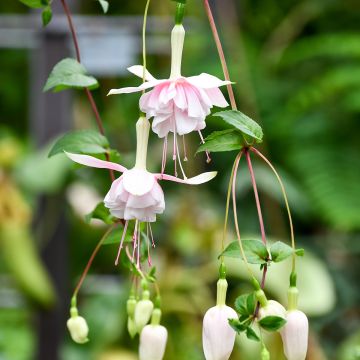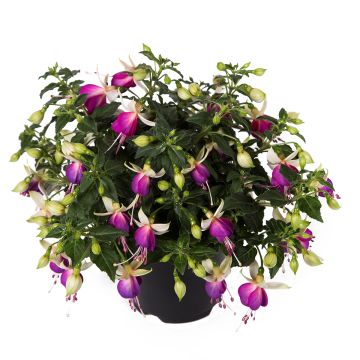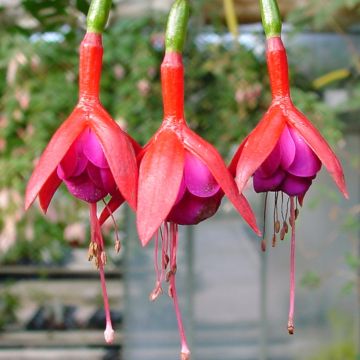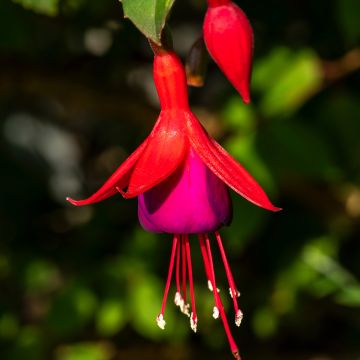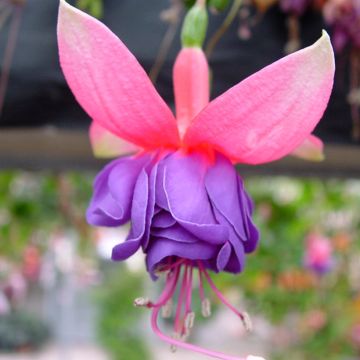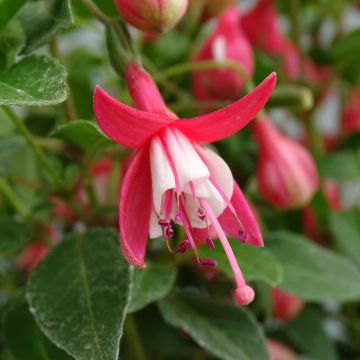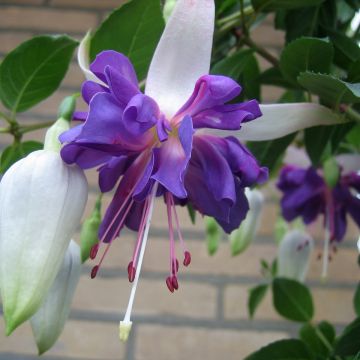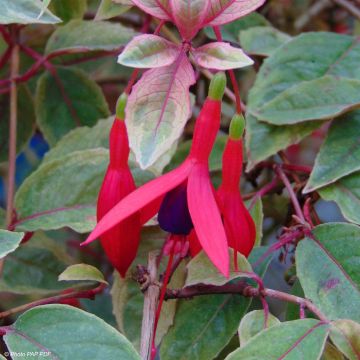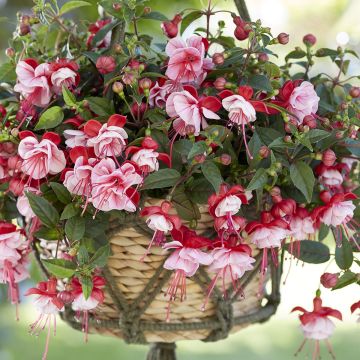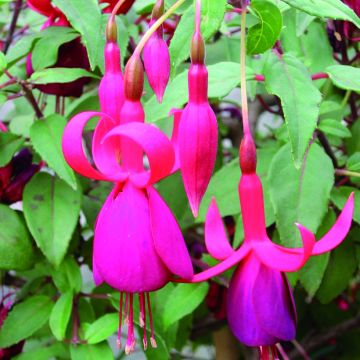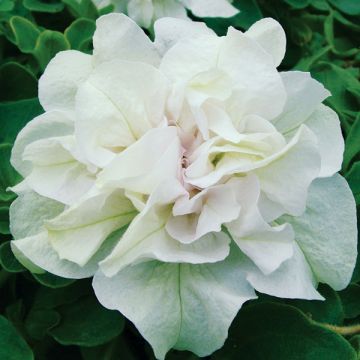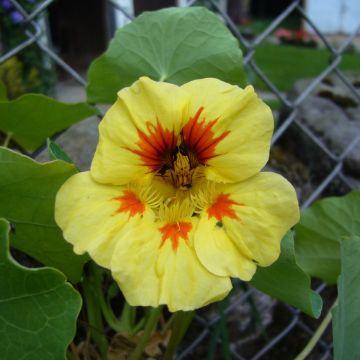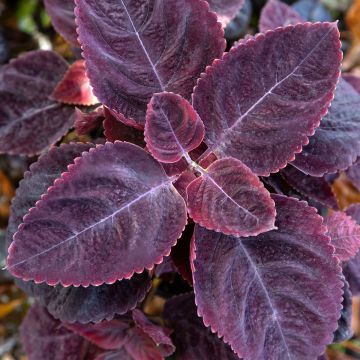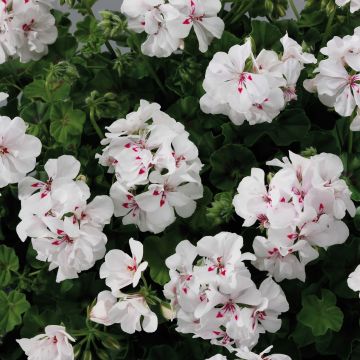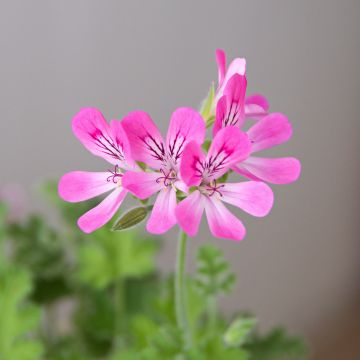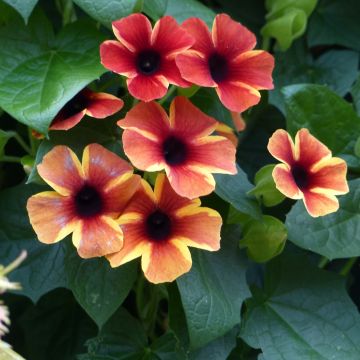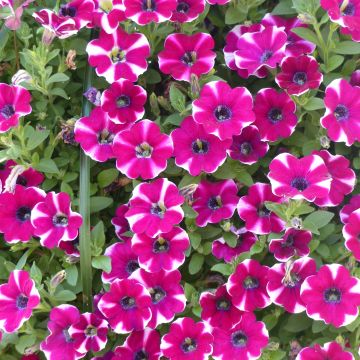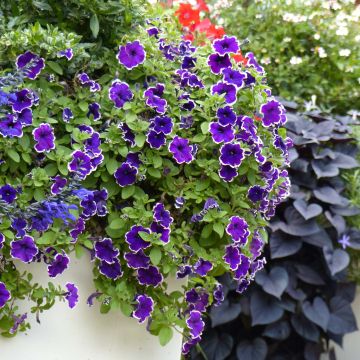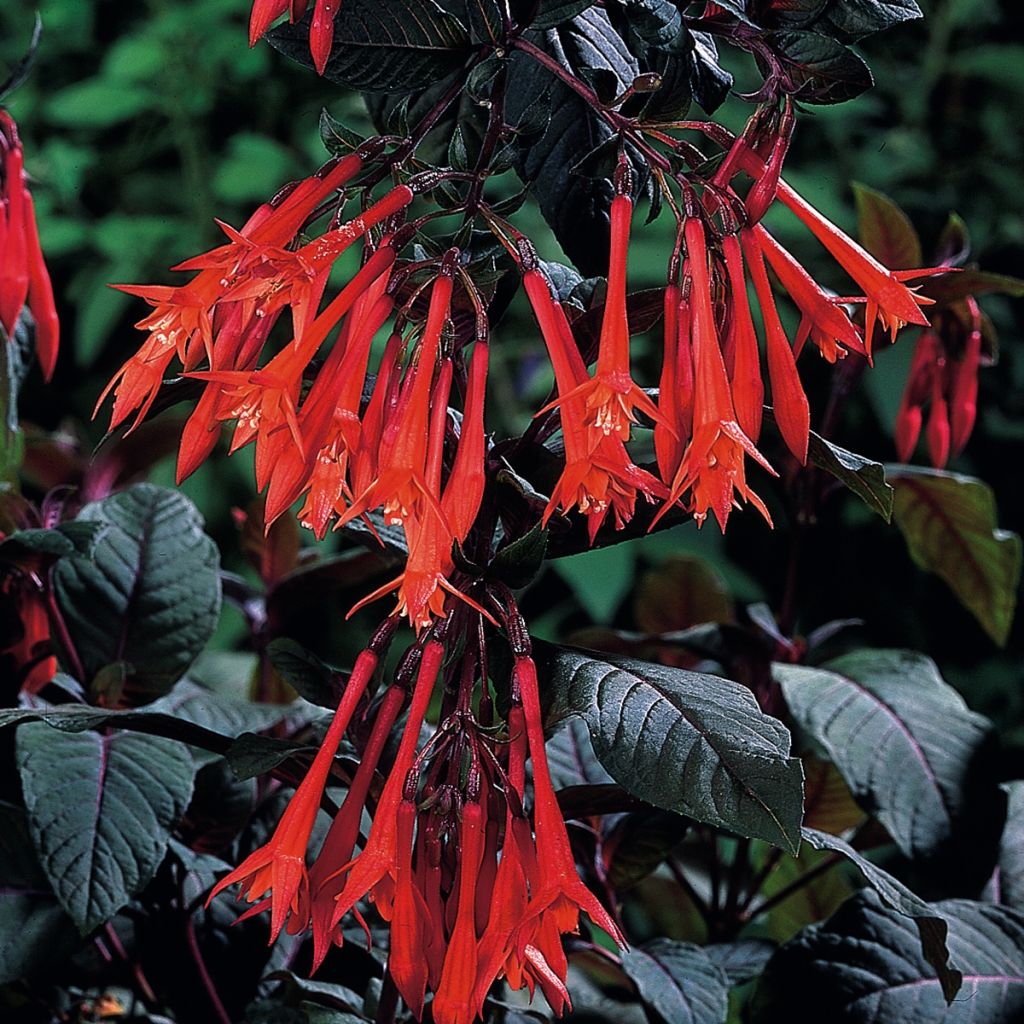

Fuchsia Gartenmeister Bonstedt
Fuchsia Gartenmeister Bonstedt
Fuchsia x triphylla Bush Gartenmeister Bonstedt
This item cannot be shipped to the selected country
Delivery charge from €5.90
More information
Schedule delivery date,
and select date in basket
This plant carries a 24 months recovery warranty
More information
We guarantee the quality of our plants for a full growing cycle, and will replace at our expense any plant that fails to recover under normal climatic and planting conditions.
From €5.90 for pickup delivery and €6.90 for home delivery
Express home delivery from €8.90.
Does this plant fit my garden?
Set up your Plantfit profile →
Description
The Fuchsia 'Gartenmeister Bonstedt' is a very beautiful hybrid variety with a bushy habit and beautiful flowering made up of thin and long tubular coral-colored flowers clustered together. They are abundantly produced and last for a long period of time, amongst beautiful green foliage tinged with bronze and purple, swaying in the wind. This selection is not very hardy, but it tolerates sun and heat better than other fuchsias. It can be grown in the ground as a perennial in milder regions, or in a large pot to be stored in the conservatory in cold climates.
The Gartenmeister Bondstedt Fuchsia is a woody-based perennial plant of the evening primrose family that forms a semi-erect and rounded bush. One of its ancestors, the fulgens Fuchsia, is a lithophyte shrub (which lives on rocks) with tuberous roots. This originates from Mexico, but also from the West Indies, where it grows on rocks, in oak forests, among mosses and ferns, at an altitude below 1500 m (4921 ft).
The Gartenmeister Bonstedt hybrid fuchsia, with fast growth, can reach 70 to 80 cm (27 to 31 in) in all directions. Its stems tinged with reddish bronze bear oval and elliptical leaves. They are medium green in color, more or less tinged and bordered with bronze to purple depending on whether the plant grows in total or partial shade, forming a beautiful background for the flowers. These usually appear from late spring to the end of summer, but can be present almost all year round when the plant is kept warm. They are grouped in dense clusters, at the end of the branches. Tubular in shape, narrow, the corollas hang at the end of the red petioles. They are composed of a long fleshy calyx with four pointed sepals, in which a corolla is embedded. Long stamens finally emerge from it. The whole flower displays an intermediate color between red, pink and orange. The foliage, theoretically evergreen, as well as the woody parts, are killed at -3°C (26.6 °F). The stump perishes when the frost persists, around -6°C (21.2 °F). Hardiness is slightly improved in well-drained soil, in a sheltered position from winds and heavy winter rains, under a thick protective mulch, with winter cover.
The Gartenmeister Bonstedt Fuchsia's colors are unmatched and its luxuriance takes the gardener to far-off places where winters are mild. This plant is a very beautiful specimen to decorate a terrace or balcony. In the ground, it performs well in the morning sun, even in regions with hot summers, as long as its base remains moist and protected from extremes. It works wonders in shady corners, bringing a lot of personality. Mixed with gray or lemon green foliage, or mixed with Coleus, it will create a lush and colorful display. Place it at the back of a border in small gardens and it will create a focal point that catches the eye. Also consider planting it among your hostas and silver candles.
Report an error about the product description
Plant habit
Flowering
Foliage
Botanical data
Fuchsia
x triphylla
Bush Gartenmeister Bonstedt
Onagraceae
Cultivar or hybrid
Other Fuchsia
Planting and care
The Gartenmeister Fuchsia thrives in shade or partial shade, in the morning sun, in a moist, well-drained, even rocky, rather fertile soil with a tendency towards acidity or neutrality. It does not appreciate scorching sun or waterlogged soils in winter. You can add some gravel to the bottom of the hole when planting. Mulch the base in summer to maintain moisture, and as it is sensitive to excessive water, reduce water intake during winter. In the case of pot cultivation, overwinter the plant in a frost-free environment, such as a bright veranda or room. This plant tolerates wintering in a slightly heated place better than other fuchsias. Its leaves become deciduous when the temperature drops below 0°C (32 °F) and its stems droop at temperatures below -3°C (26.6 °F). The stump cannot withstand prolonged freezing below -5 to -6°C (23 to 21.2 °F).
Planting period
Intended location
Care
This item has not been reviewed yet - be the first to leave a review about it.
Plug plants - Annuals
Haven't found what you were looking for?
Hardiness is the lowest winter temperature a plant can endure without suffering serious damage or even dying. However, hardiness is affected by location (a sheltered area, such as a patio), protection (winter cover) and soil type (hardiness is improved by well-drained soil).

Photo Sharing Terms & Conditions
In order to encourage gardeners to interact and share their experiences, Promesse de fleurs offers various media enabling content to be uploaded onto its Site - in particular via the ‘Photo sharing’ module.
The User agrees to refrain from:
- Posting any content that is illegal, prejudicial, insulting, racist, inciteful to hatred, revisionist, contrary to public decency, that infringes on privacy or on the privacy rights of third parties, in particular the publicity rights of persons and goods, intellectual property rights, or the right to privacy.
- Submitting content on behalf of a third party;
- Impersonate the identity of a third party and/or publish any personal information about a third party;
In general, the User undertakes to refrain from any unethical behaviour.
All Content (in particular text, comments, files, images, photos, videos, creative works, etc.), which may be subject to property or intellectual property rights, image or other private rights, shall remain the property of the User, subject to the limited rights granted by the terms of the licence granted by Promesse de fleurs as stated below. Users are at liberty to publish or not to publish such Content on the Site, notably via the ‘Photo Sharing’ facility, and accept that this Content shall be made public and freely accessible, notably on the Internet.
Users further acknowledge, undertake to have ,and guarantee that they hold all necessary rights and permissions to publish such material on the Site, in particular with regard to the legislation in force pertaining to any privacy, property, intellectual property, image, or contractual rights, or rights of any other nature. By publishing such Content on the Site, Users acknowledge accepting full liability as publishers of the Content within the meaning of the law, and grant Promesse de fleurs, free of charge, an inclusive, worldwide licence for the said Content for the entire duration of its publication, including all reproduction, representation, up/downloading, displaying, performing, transmission, and storage rights.
Users also grant permission for their name to be linked to the Content and accept that this link may not always be made available.
By engaging in posting material, Users consent to their Content becoming automatically accessible on the Internet, in particular on other sites and/or blogs and/or web pages of the Promesse de fleurs site, including in particular social pages and the Promesse de fleurs catalogue.
Users may secure the removal of entrusted content free of charge by issuing a simple request via our contact form.
The flowering period indicated on our website applies to countries and regions located in USDA zone 8 (France, the United Kingdom, Ireland, the Netherlands, etc.)
It will vary according to where you live:
- In zones 9 to 10 (Italy, Spain, Greece, etc.), flowering will occur about 2 to 4 weeks earlier.
- In zones 6 to 7 (Germany, Poland, Slovenia, and lower mountainous regions), flowering will be delayed by 2 to 3 weeks.
- In zone 5 (Central Europe, Scandinavia), blooming will be delayed by 3 to 5 weeks.
In temperate climates, pruning of spring-flowering shrubs (forsythia, spireas, etc.) should be done just after flowering.
Pruning of summer-flowering shrubs (Indian Lilac, Perovskia, etc.) can be done in winter or spring.
In cold regions as well as with frost-sensitive plants, avoid pruning too early when severe frosts may still occur.
The planting period indicated on our website applies to countries and regions located in USDA zone 8 (France, United Kingdom, Ireland, Netherlands).
It will vary according to where you live:
- In Mediterranean zones (Marseille, Madrid, Milan, etc.), autumn and winter are the best planting periods.
- In continental zones (Strasbourg, Munich, Vienna, etc.), delay planting by 2 to 3 weeks in spring and bring it forward by 2 to 4 weeks in autumn.
- In mountainous regions (the Alps, Pyrenees, Carpathians, etc.), it is best to plant in late spring (May-June) or late summer (August-September).
The harvesting period indicated on our website applies to countries and regions in USDA zone 8 (France, England, Ireland, the Netherlands).
In colder areas (Scandinavia, Poland, Austria...) fruit and vegetable harvests are likely to be delayed by 3-4 weeks.
In warmer areas (Italy, Spain, Greece, etc.), harvesting will probably take place earlier, depending on weather conditions.
The sowing periods indicated on our website apply to countries and regions within USDA Zone 8 (France, UK, Ireland, Netherlands).
In colder areas (Scandinavia, Poland, Austria...), delay any outdoor sowing by 3-4 weeks, or sow under glass.
In warmer climes (Italy, Spain, Greece, etc.), bring outdoor sowing forward by a few weeks.

































